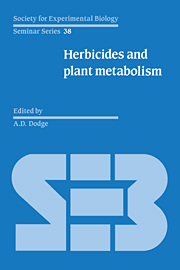Book contents
- Frontmatter
- Contents
- Contributors
- Preface
- Herbicide use and invention
- Herbicides interacting with photosystem II
- Herbicides interacting with photosystem I
- Carotenoids and chlorophylls: herbicidal inhibition of pigment biosynthesis
- Herbicides inhibiting lipid synthesis
- The shikimate pathway as a target for herbicides
- Herbicides that inhibit the biosynthesis of branched chain amino acids
- Glutamine synthetase and its inhibition
- Metabolism of herbicides – detoxification as a basis of selectivity
- Bioactivated herbicides
- Mechanisms involved in the evolution of herbicide resistance in weeds
- Conferring herbicide resistance on susceptible crops
- Herbicide glossary
- Herbicide index
- General index
Herbicides inhibiting lipid synthesis
Published online by Cambridge University Press: 04 August 2010
- Frontmatter
- Contents
- Contributors
- Preface
- Herbicide use and invention
- Herbicides interacting with photosystem II
- Herbicides interacting with photosystem I
- Carotenoids and chlorophylls: herbicidal inhibition of pigment biosynthesis
- Herbicides inhibiting lipid synthesis
- The shikimate pathway as a target for herbicides
- Herbicides that inhibit the biosynthesis of branched chain amino acids
- Glutamine synthetase and its inhibition
- Metabolism of herbicides – detoxification as a basis of selectivity
- Bioactivated herbicides
- Mechanisms involved in the evolution of herbicide resistance in weeds
- Conferring herbicide resistance on susceptible crops
- Herbicide glossary
- Herbicide index
- General index
Summary
Introduction
A number of herbicides have been reported, over the years, to inhibit lipid metabolism. The effects of many of these compounds are believed to be secondary. However, three classes of herbicides may have a more specific effect on fatty acid (and lipid) synthesis. These groups of compounds are the substituted pyridazinones, thiocarbamates and a rather diverse class of graminaceae-selective herbicides which include the oxyphenoxy propionic acids and cyclohexanediones. These three groups form the substance of this brief review.
The overall topic of herbicides and lipid metabolism has been reviewed by several authors (Duke, 1985; Fedtke, 1982; Rivera & Penner, 1979; St John, 1982).
Substituted pyridazinones
The mode of action of pyridazinone herbicides has been reviewed recently and appears to involve several target sites in plants (St John, 1982; Duke, 1985). Depending on the exact structure of the compound, and the plant test species, the effects have been noted to include inhibition of photosynthetic O2 evolution, of pigment synthesis and changes in fatty acid composition.
Two substituted pyridazinones which have excited particular interest with regard to their effects on fatty acid formation are San 9785, (BASF 13 338; 4-chloro-5-(dimethylamino)-2-phenyl-3(2H) pyridazinone) and San 6706 (metflurazon); 4-chloro-5-(dimethylamino)-2-(α,α,α-trifluoro-m-tolyl)-3(2H)-pyridazinone)(Figure 1). It was noted by St John (1976) that San 9785 altered the proportions of linoleic and α linolenic acids in monogalactosyl- and digalactosyldiacylglycerol. In contrast, San 9774 merely reduced the proportion of α-linolenate in monogalactosyldiacyl-glycerol alone.
- Type
- Chapter
- Information
- Herbicides and Plant Metabolism , pp. 73 - 96Publisher: Cambridge University PressPrint publication year: 1990

